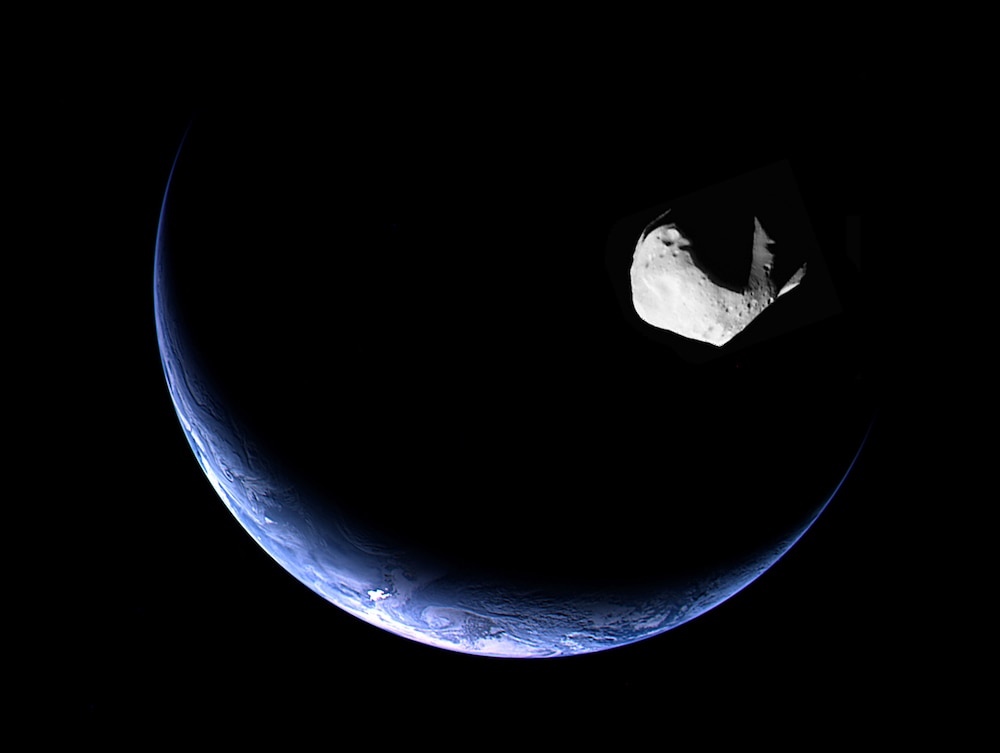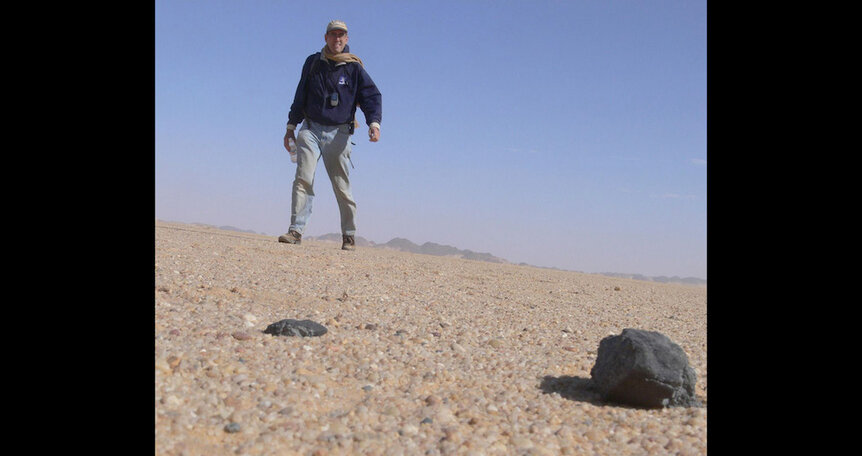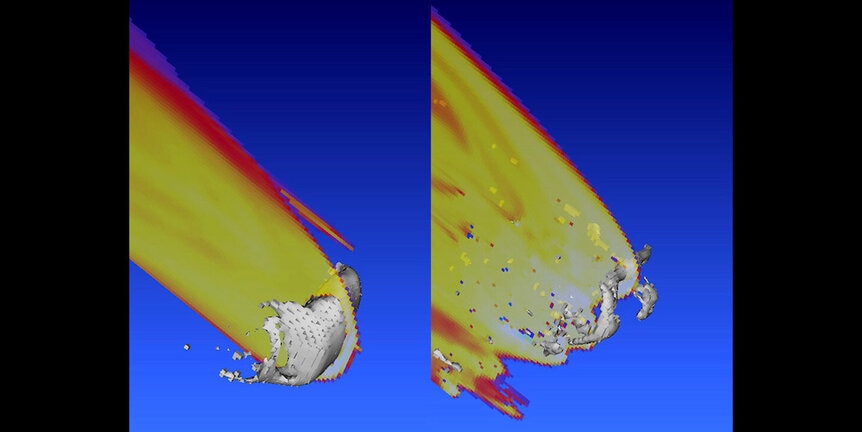Create a free profile to get unlimited access to exclusive videos, sweepstakes, and more!
Meteorites from a 2008 asteroid impact came from the space rock’s backside
Debris pattern reveals how asteroid 2008 TC3 broke apart.

On Oct. 7, 2008, just after midnight UTC, an asteroid 4 meters across came screaming into Earth’s atmosphere.
It started feeling pressure from the thin air around 100 kilometers above the ground. Traveling at a downward angle of about 20° at 46,000 kilometers per hour — a dozen times faster than a rifle bullet — the building pressure as it rammed through ever-denser air caused the gas in front of it to be violently compressed and heat up, so much so that the asteroid heated up as well. Both the air in front and the asteroid itself started to glow by the time it was 70 km above the Earth. Seconds later, around 42 kilometers and then again at 37 km up, it partially exploded, then one second later a final pulse of energy caused the asteroid to completely disintegrate.
The total energy released was equivalent to over a thousand tons of TNT exploding, much of that in the form of a debris cloud expanding away. It contained dust and rocks, the remains of the original 80 tons of material making up the asteroid. This then rained meteorites down onto the ground, a region of the Sudan’s Nubian Desert in Africa, with meteorites ranging in size from specks of dust to ones that weighed several hundred grams.
The asteroid, called 2008 TC3, had been discovered just 19 hours previously in images taken by the Catalina Sky Survey, which sweeps the sky looking for dangerous near-Earth asteroids. An alert was sent out, more observations taken, and it quickly became clear this rock was going to hit Earth: The very first time one was ever seen before impact. Over 900 observations were made in that time by professional and amateur astronomers alike, which gave a very precise trajectory for TC3, including where it would impact.
In December a search began for meteorites, and within days several were found. Spread out over an area 30 kilometers long and about 7 wide, 600 meteorites were eventually found totaling about 11 kilograms.
Then things got weird. The scientists made very careful measurements of which meteorites were found where, and a pattern emerged: Following the trajectory of the asteroid downrange, the pieces that fell the farthest uprange were smaller, while pieces that made it farther downrange were bigger. Not only that, the uprange small pieces from 1 to 50 grams were confined to a narrow path only a kilometer or so wide, but the downrange larger rocks 100 to 400 grams were dispersed farther, some found several kilometers away from the ground path of the incoming asteroid. The pattern looks like a trumpet bell, narrow at one end and wider the farther along you go.
Why?
New research using sophisticated computer modeling of how an asteroid breaks up as it slams into Earth’s air has provided an answer, and it has to do with the shape of the asteroid and the details of what happens as the huge forces generated by its rapid motion caused it to break up [link to paper].
As the asteroid approached Earth, observations indicated it brightened and dimmed on a regular cycle, indicating it was highly elongated like a Tic Tac or a wide canoe, and rotating very rapidly, once every 49 seconds. As it entered the Earth’s atmosphere it settled into a single orientation, with its longest dimension ramming through the air (as opposed to narrow end-on like an arrow).
Compressing air that hard heats it up, which in turn heats up the rock on the side facing into the direction of travel. Material started to melt and blow back, a process called ablation. But the asteroid was moving so rapidly it was punching a hole in the air, with a near-vacuum behind it. The small bits of ablated material fell into this vacuum wake, and the high pressure from the shock wave around the main mass of the asteroid kept them there. Still hot, many of the pieces continued to vaporize and shrink, creating smaller particles that were essentially dust.
At the same time the wave of pressure and heating moved through the solid body of the asteroid, dissolving it from front to back. Within seconds it was so eroded it didn’t have enough structural strength to withstand the onslaught, and it collapsed. At this point all that was left was material along the backside of the asteroid, which crumbled into large pieces.
The wake vacuum collapsed as well since the asteroid was now gone. The material stuck there was no longer protected and was suddenly exposed to the huge velocity of air moving past it. The small pieces slowed fiercely, eventually falling to the ground not far from the spot over which the final disintegration occurred.
But bigger pieces were more massive and retained their velocity for longer, so they fell farther downrange. That explains why different sizes were found at different locations downrange. But why did the small pieces fall along a narrow path and the big ones were more spread out?
The small ones stayed behind the asteroid for the most part in the wake vacuum, so they fell along that same direction. But when the final collapse occurred all the big pieces suddenly found themselves in open air, and each generated its own strong shock wave of air moving around them. Pieces near each other would feel a violent push away from each other as their individual shock waves interacted, a sideways shove perpendicular to the direction of travel. This gave them some velocity to the side, so when they eventually hit the ground farther downrange they were more spread out.
Most of the meteorites found in this case were therefore from the backside of the asteroid; the material from the front was mostly in the form of dust that trailed behind it to create the train of vaporized material or expanded outward in dust clouds as the asteroid disintegrated.
This may not be the case for every incoming space rock, but this result does help planetary scientists understand the asteroid 2008 TC3 better. For example, the larger rocks that fell to the right of the downward path probably came from the right side of the asteroid, and ones to the left from the asteroid’s left side. Examining the meteorites showed that some materials were well mixed throughout the asteroid, with no pockets of material preferentially in one place. That gives hints about the history of the asteroid.
The physics of hypervelocity impacts is extremely complex and difficult to model. The success of this model to mimic what happened to 2008 TC3 as it broke apart shows that it’s possible to learn quite a bit more about these rocks as they come in, and understand better the processes that almost — but not necessarily completely — destroy them. That in turn means we can better understand the effect they have on the air and ground as they fall. That’s important to know better what kind of damage they can do. Rocks like TC3, a few meters across, hit us a few times a year, and bigger ones are commensurately more rare. But they can do considerable damage — just ask the dinosaurs, except you can’t for obvious reasons — so understanding why and how can have real-world implications for us living at the bottom of Earth’s ocean of protective air.




























